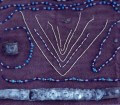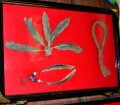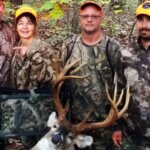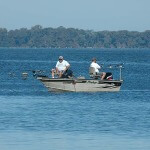Editor’s Note: Most people think of American frontiersmen as the fur traders, pioneers and European settlers who came to this country. But the true frontiersmen were the people who lived here long before Columbus ever discovered America. These civilizations hunted, farmed, lived, died, were buried and were lost or abandoned. If a people are to know their future, they must learn and understand their past. The treasure hunter who helps a people find and know this past performs a service for the early people, their descendants and all mankind. Many outdoorsmen enjoy studying early times and using their metal detectors. Always be sure to check state and federal regulations associated with treasure hunting. In 2013, I met 74-year old Charles Griffin of Shelby County, Alabama, who had been hunting arrowheads and Indian artifacts for 67 years. Like many youngsters with no TV or sports teams to play on in the country, Griffin had been and still is fascinated with the stone tools, arrowheads and pottery he found on his family’s 100-acre farm that his great, great grandfather settled in 1816 after fighting with General Andrew Jackson in the Indian Wars. http://youtu.be/iopUtnpGsKI.
“A big spring boiled up out of the ground on our property where I found many beautiful artifacts,” Griffin recalls. “Some of the artifacts I discovered were very old, dating back to the Archaic Period (8,000 BC–2,000 BC). I found some artifacts that dated to 1103.” Griffin also became fascinated with the Paleo-Indian Period people who lived from 1,500 – 7,000 BC, in small bands of five – seven individuals. More than this number in the clan meant the members couldn’t feed them by hunting and scavenging. Griffin considered them the true American survivors. If they killed an animal, they stayed on the site where they had taken it until they had eaten all they could before moving.
 “I located one rock shelter with black soot on the ceiling, and the ground was greasy,” Griffin explains. “Nomadic people must have lived there for awhile. There I found some atlatls, spear throwers, spear points and stone knives. I also found one Dalton point – perhaps 8,000 years old – that looked like the points made in Tennessee. Central Alabama today is only about a 3- or a 4-hour drive in an automobile to the place where this point probably originated. But to get that far on foot, kill animals and feed on those animals probably took several months.”
“I located one rock shelter with black soot on the ceiling, and the ground was greasy,” Griffin explains. “Nomadic people must have lived there for awhile. There I found some atlatls, spear throwers, spear points and stone knives. I also found one Dalton point – perhaps 8,000 years old – that looked like the points made in Tennessee. Central Alabama today is only about a 3- or a 4-hour drive in an automobile to the place where this point probably originated. But to get that far on foot, kill animals and feed on those animals probably took several months.”
As archaeologists and artifact hunters discovered these old stone tools and pottery from the earliest American frontiersmen, they named the different styles of stone tools for the locations or the people first identifying particular styles of stone implements. “Although my family thought we were the early pioneers in our section of Alabama, when I picked up Dalton points on our property, I realized people lived there 8,000 years before my family arrived,” Griffin explains.
 Modern day artifact hunters didn’t invent relic hunting. Early people also looked for all types of stone tools after battles, around settlements and at rock shelters. Even if knives and arrow points were damaged, they simply chipped away the damaged part of the stone point and reshaped or refashioned it. When Griffin first started collecting Native American artifacts, no laws prohibited the collecting, trading and selling of these artifacts. But in 1989, the Native American Graves Protection and Repatriation Act was enacted. The law dictated that any artifact found on top of the ground should be reburied. Before you start hunting and collecting artifacts, you need to check the state and federal laws relating to finding and collecting these early American tools, pots, spear points and knives. According to Griffin, “I never mark a spot where I’m hunting artifacts. Newcomers to the sport may want to use a hand-held GPS receiver to identify the sites and note what types of artifacts are found there.”
Modern day artifact hunters didn’t invent relic hunting. Early people also looked for all types of stone tools after battles, around settlements and at rock shelters. Even if knives and arrow points were damaged, they simply chipped away the damaged part of the stone point and reshaped or refashioned it. When Griffin first started collecting Native American artifacts, no laws prohibited the collecting, trading and selling of these artifacts. But in 1989, the Native American Graves Protection and Repatriation Act was enacted. The law dictated that any artifact found on top of the ground should be reburied. Before you start hunting and collecting artifacts, you need to check the state and federal laws relating to finding and collecting these early American tools, pots, spear points and knives. According to Griffin, “I never mark a spot where I’m hunting artifacts. Newcomers to the sport may want to use a hand-held GPS receiver to identify the sites and note what types of artifacts are found there.”
How to Find Areas to Look for Artifacts:
Charles Griffin explains, “If I’m hunting a new area, I start on the ridges. If I’m hunting a field close to a creek or a river, I look for the highest point in that field near fresh water. The early people wanted to be above the flood plain and to be able to see any enemies approaching. I’ll also use topo maps to search for a creek or a river on a property and then a bend in a river where early people would set-up camp.”
Also today many artifact hunters use www.mytopo.com to get topographical maps they can study to identify likely looking places and also learn property owners’ information.
 How to Hunt Artifacts – What to Take with You:
How to Hunt Artifacts – What to Take with You:
“I always take one tool with me when hunting artifacts – a ‘Flipper,’ a stick about 3-feet long with a nail in the end of it,” Griffin reports. “If I see a piece of flint that looks like it’s been chipped, I’ll use that flipper to turn it over. I’ll only hunt for 2 or 3 hours or perhaps until dark. I have a pack with me as well as snacks and bottled water. That’s it.”
How to Verify the Age of the Artifacts:
Griffin has many pieces that are papered, which means these items have papers of certification and have been declared authentic. When an artifact’s papered, you’ll often learn who has found it, where and when, what type of material it’s made of, and how the artifact has been used. The more information a collector has about the object he’s found, the more valuable the piece becomes.
The individual recognized as an authenticator (generally you can meet them at relic shows or contact them through archaeology groups) has spent years studying ancient tools and decorations to authenticate and issue papers on found artifacts. Most of the artisans who built stone tools had certain styles of knapping rocks that were as verifiable as an artist’s painting. If the flaking (chipping the rock) of a certain point doesn’t match the style of a certain period, a particular area of the country or a specific group of artisans, the authenticator knows that the point’s a fake.
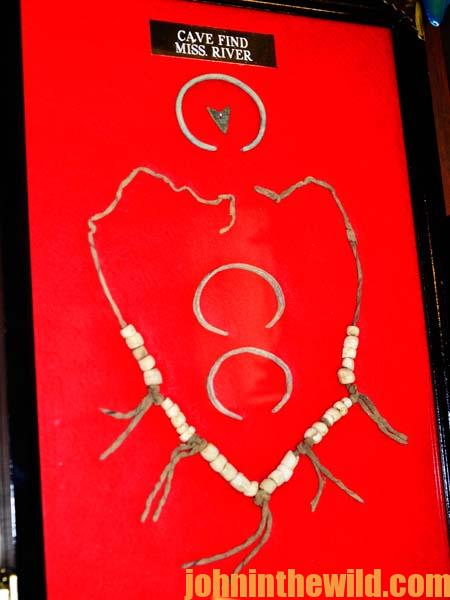 Chipping stones to make cutlery or tools was a refined art form. Each group of people at certain times and in particular regions demonstrated similar forms of making tools. With no instruction books, fathers passed their knapping skills down to their sons. By studying the way stones were knapped by a group of people, during a specific time of history, authenticators can spot fakes.
Chipping stones to make cutlery or tools was a refined art form. Each group of people at certain times and in particular regions demonstrated similar forms of making tools. With no instruction books, fathers passed their knapping skills down to their sons. By studying the way stones were knapped by a group of people, during a specific time of history, authenticators can spot fakes.
As Griffin reports, “With arrowheads, atlatls, knives and any sharp stone tools, the point of that stone tool doesn’t mean anything. However, the back of the point called the stem enables you to tell the time period of its creation. If the tool is fluted, you’ll know it was made during the Paleolithic time about 40,000 years ago in history. If it has a corner notch on the stem, that point was made during the Archaic Period, about 8,000 years ago. The Paleolithic is the favored point. The Archaic is the next favorite point, and the Woodland Period points are the most valuable.”
The book, “Sun Circles and Human Hands: The Southeastern Indians Art and Industries” by Emma Lila Fundaburk, is available from Amazon as is a price guide, Rob Overstreet’s, “The Official Overstreet Identification and Price Guide to Indian Arrowheads,” which comes out every 18 months.

